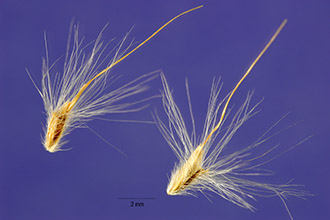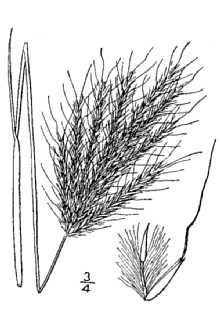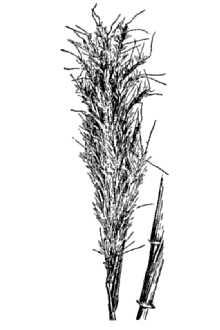Silver Bluestem
Scientific Name: Bothriochloa saccharoides (Sw.) Rydb.

| General Information | |
|---|---|
| Usda Symbol | BOSA |
| Group | Monocot |
| Life Cycle | Perennial |
| Growth Habits | Graminoid |
| Native Locations | BOSA |
Plant Guide
Use soil moisture sensors to measure the soil moisture of Silver Bluestem.
Fact Sheet
Alternate Name
Andropogon saccharoides
Uses
Silver bluestem is used primarily for grazing. Cattle graze it a few weeks in the spring, but little after the seedheads form. It can be grazed some during the winter if livestock are fed a protein supplement. Goats relish the seedheads when seed is in the dough stage. This grass is usually not seeded nor managed to control erosion on critical areas, but established itself readily on denuded soils and overgrazed ranges.
Status
Please consult the PLANTS Web site and your State Department of Natural Resources for this plant’s current status, such as, state noxious status and wetland indicator values.
Description
Grass Family (Poaceae). Silver bluestem is a native, warm-season, short-lived perennial bunch grass. The height is between 2 to 3 feet. The leaf blade is 2 to 8 inches long. The stems are round at the base, but sometimes branching at nodes. The lower part is purplish throughout the growing season and usually has a ring of white hairs at the nodes. Stems turn irregularly at each node. The seedhead is a raceme that is silky white soon after it emerges from the sheath. Distribution: For current distribution, please consult the Plant Profile page for this species on the PLANTS Web site.
Management
It is cut for hay only when associated with other grasses, such as little (Schizachyrium scoparium) and big bluestem (Andropogon gerardii), This grass increases on ranges that are grazed continuously, It is an invader on ranges in poor condition, Use soil moisture sensors to measure the soil moisture of Silver Bluestem., Range managed to maintain this grass in the plant community should be grazed no more than 50 percent of the current year's growth and grazing should be deferred 45 to 60 days in the spring every 2 to 3 years,
Establishment
Growth starts in the spring when daily temperature is 70 to 75 degrees F. The seedheads emerge 3 to 4 weeks later with the seeds ripening during a 4- to 6-week period. Silver bluestem is a prolific seed producer. It grows best on loamy soils underlain by limestone. It grows well on clays and clay loams throughout the blackland resource areas of the South. Further west, it grows on rocky slopes and coarser textured soils. It does not grow well on moist sites. Cultivars, Improved and Selected Materials (and area of origin) Please contact your local NRCS Field Office.
Plant Traits
Growth Requirements
| Temperature, Minimum (°F) | -23 |
|---|---|
| Adapted to Coarse Textured Soils | Yes |
| Adapted to Fine Textured Soils | No |
| Adapted to Medium Textured Soils | Yes |
| Anaerobic Tolerance | None |
| CaCO3 Tolerance | Medium |
| Cold Stratification Required | No |
| Drought Tolerance | High |
| Fertility Requirement | Low |
| Fire Tolerance | High |
| Frost Free Days, Minimum | 140 |
| Hedge Tolerance | None |
| Moisture Use | Medium |
| pH, Maximum | 7.2 |
| pH, Minimum | 6.5 |
| Precipitation, Maximum | 48 |
| Precipitation, Minimum | 10 |
| Root Depth, Minimum (inches) | 12 |
| Salinity Tolerance | Low |
| Shade Tolerance | Intolerant |
Morphology/Physiology
| After Harvest Regrowth Rate | Moderate |
|---|---|
| Toxicity | None |
| Resprout Ability | No |
| Shape and Orientation | Semi-Erect |
| Active Growth Period | Summer |
| Bloat | None |
| Coppice Potential | No |
| Fall Conspicuous | Yes |
| Fire Resistant | Yes |
| Flower Conspicuous | No |
| Foliage Color | Green |
| Foliage Porosity Summer | Porous |
| Foliage Porosity Winter | Porous |
| Foliage Texture | Fine |
| Fruit/Seed Conspicuous | No |
| Growth Form | Bunch |
| Growth Rate | Moderate |
| Height, Mature (feet) | 2.0 |
| Known Allelopath | No |
| Leaf Retention | No |
| Lifespan | Short |
| Low Growing Grass | Yes |
| Nitrogen Fixation | None |
| Fruit/Seed Color | Brown |
Reproduction
| Propagated by Seed | Yes |
|---|---|
| Propagated by Sod | No |
| Propagated by Sprigs | No |
| Propagated by Tubers | No |
| Fruit/Seed Persistence | No |
| Seed per Pound | 80000 |
| Seed Spread Rate | Moderate |
| Seedling Vigor | Medium |
| Small Grain | No |
| Vegetative Spread Rate | Moderate |
| Propagated by Corm | No |
| Propagated by Container | No |
| Propagated by Bulb | No |
| Propagated by Bare Root | No |
| Fruit/Seed Period End | Fall |
| Fruit/Seed Period Begin | Summer |
| Fruit/Seed Abundance | Medium |
| Commercial Availability | Contracting Only |
| Bloom Period | Summer |
| Propagated by Cuttings | No |
Suitability/Use
| Veneer Product | No |
|---|---|
| Pulpwood Product | No |
| Protein Potential | Low |
| Post Product | No |
| Palatable Human | No |
| Palatable Graze Animal | Low |
| Palatable Browse Animal | Low |
| Nursery Stock Product | No |
| Naval Store Product | No |
| Lumber Product | No |
| Fodder Product | Yes |
| Christmas Tree Product | No |
| Berry/Nut/Seed Product | No |


